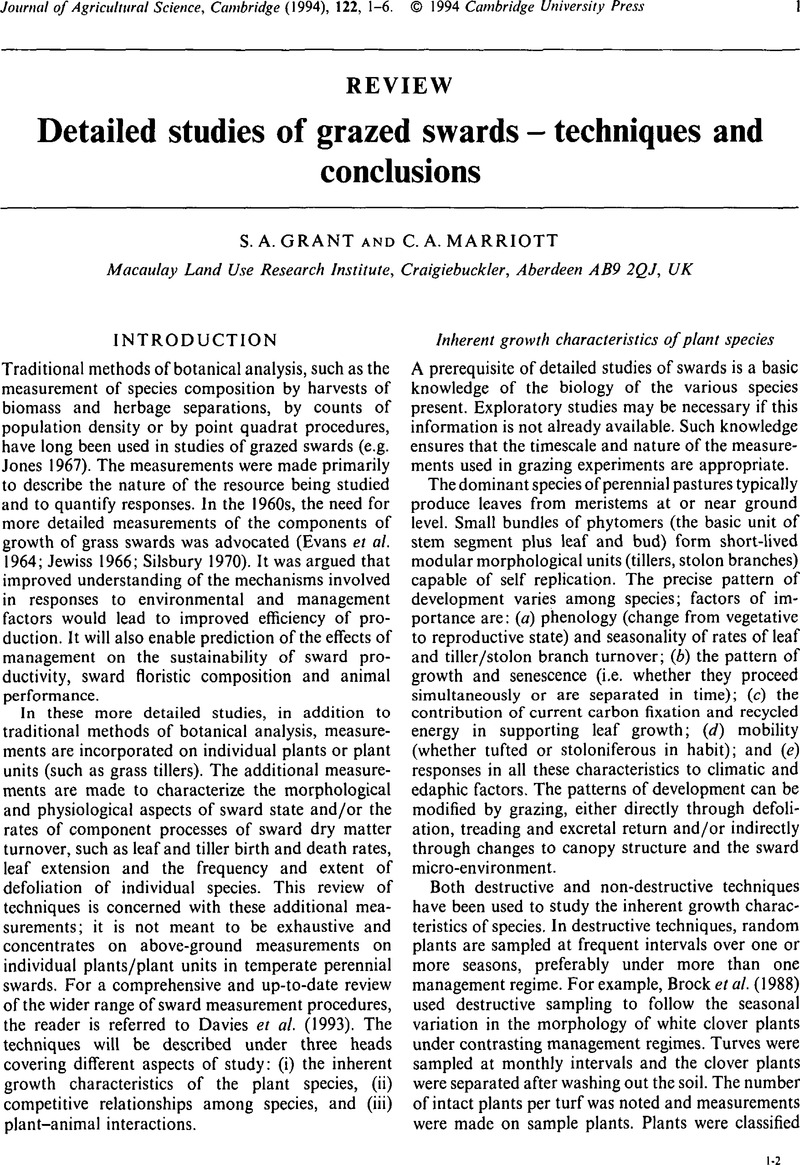Crossref Citations
This article has been cited by the following publications. This list is generated based on data provided by Crossref.
ELGERSMA, A.
and
FENGRUI, LI
1997.
Effects of cultivar and cutting frequency on dynamics of stolon growth and leaf appearance in white clover grown in mixed swards.
Grass and Forage Science,
Vol. 52,
Issue. 4,
p.
370.
Gomide, Carlos Augusto Miranda
and
Gomide, José Alberto
2000.
Morfogênese de cultivares de Panicum maximum jacq..
Revista Brasileira de Zootecnia,
Vol. 29,
Issue. 2,
p.
341.
Barbosa, Rodrigo Amorim
Nascimento Júnior, Domicio do
Euclides, Valéria Pacheco Batista
Regazzi, Adair José
and
Fonseca, Dilermando Miranda da
2002.
Características Morfogênicas e Acúmulo de Forragem do Capim-Tanzânia (Panicum maximum Jacq. cv. Tanzânia) em Dois Resíduos Forrageiros Pós-Pastejo.
Revista Brasileira de Zootecnia,
Vol. 31,
Issue. 2,
p.
583.
Trindade, José Pedro Pereira
and
Rocha, Marta Gomes da
2002.
REBROTAMENTO DE CAPIM CANINHA (Andropogon lateralis Nees) SOB O EFEITO DE PASTEJO E FOGO.
Ciência Rural,
Vol. 32,
Issue. 1,
p.
141.
Paciullo, Domingos Sávio Campos
Deresz, Fermino
Aroeira, Luiz Januário Magalhães
Morenz, Mirton José Frota
and
Verneque, Rui da Silva
2003.
Morfogênese e acúmulo de biomassa foliar em pastagem de capim-elefante avaliada em diferentes épocas do ano.
Pesquisa Agropecuária Brasileira,
Vol. 38,
Issue. 7,
p.
881.
Eggers, Lilian
Cadenazzi, Mónica
and
Boldrini, Ilsi Iob
2004.
Phyllochron of Paspalum notatum FL. and Coelorhachis selloana (HACK.) camus in natural pasture.
Scientia Agricola,
Vol. 61,
Issue. 4,
p.
353.
Sousa, Braulio Maia de Lana
Nascimento Júnior, Domicio do
Monteiro, Hélida Christhine de Freitas
and
Fonseca, Dilermando Miranda da
2012.
Dynamics of production and forage utilization on elephant grass pastures managed with different post-grazing heights.
Revista Brasileira de Zootecnia,
Vol. 41,
Issue. 8,
p.
1840.
Lopes de Sá, O. A. A.
Lara, M. A. S.
Evangelista, A. R.
Bernardes, T. F.
and
Casagrande, D. R.
2015.
Estimates of the leaf area of forage peanut for use in morphogenetic assessment.
Grass and Forage Science,
Vol. 70,
Issue. 2,
p.
335.
Pereira, Juliana C
Gomes, Fernanda K
Oliveira, Michael DBL
Lara, Marcio AS
Bernardes, Thiago F
and
Casagrande, Daniel R
2017.
Defoliation management affects morphogenetic and structural characteristics of mixed pastures of brachiaria grass and forage peanut.
African Journal of Range & Forage Science,
Vol. 34,
Issue. 1,
p.
13.
Tamele, O. H.
Lopes de Sá, O. A. A.
Bernardes, T. F.
Lara, M. A. S.
and
Casagrande, D. R.
2018.
Optimal defoliation management of brachiaria grass–forage peanut for balanced pasture establishment.
Grass and Forage Science,
Vol. 73,
Issue. 2,
p.
522.
Alberto Depablos Alviarez, Luis
Grossi Costa Homem, Bruno
Hevilen do Couto, Paula
Carlos Batista Dubeux, José
Fernandes Bernardes, Thiago
Rume Casagrande, Daniel
and
André Stefanelli Lara, Marcio
2020.
Managing “Marandu” palisadegrass and calopo pastures based on light interception.
Grass and Forage Science,
Vol. 75,
Issue. 4,
p.
447.
Rodrigues, Carlindo S.
Matos, Luís H. A. de
Pina, Douglas dos S.
Leite, Vagner M.
Silva, Paula de A.
Silva, Robério R.
Pereira, Taiala C. de J.
Alba, Henry D. R.
and
Carvalho, Gleidson G. P. de
2023.
Influence of Slow- or Fast-Release Nitrogen in Xaraés Grass under Tropical Conditions.
Grasses,
Vol. 2,
Issue. 1,
p.
47.
Spasiani, Paola Palauro
Homem, Bruno Grossi Costa
Lima, Italo Braz Gonçalves de
Guimarães, Bianca Costa
Medeiros, Elias Silva de
Muir, James Pierre
Oliveira, Marcelo Silva de
Boddey, Robert Michael
Casagrande, Daniel Rume
and
Cullen, Brendan
2023.
Light competition is the key factor determining spatio-temporal variability in legume proportion within Marandu palisadegrass–forage peanut mixed pastures.
Crop & Pasture Science,
Vol. 74,
Issue. 9,
p.
898.





